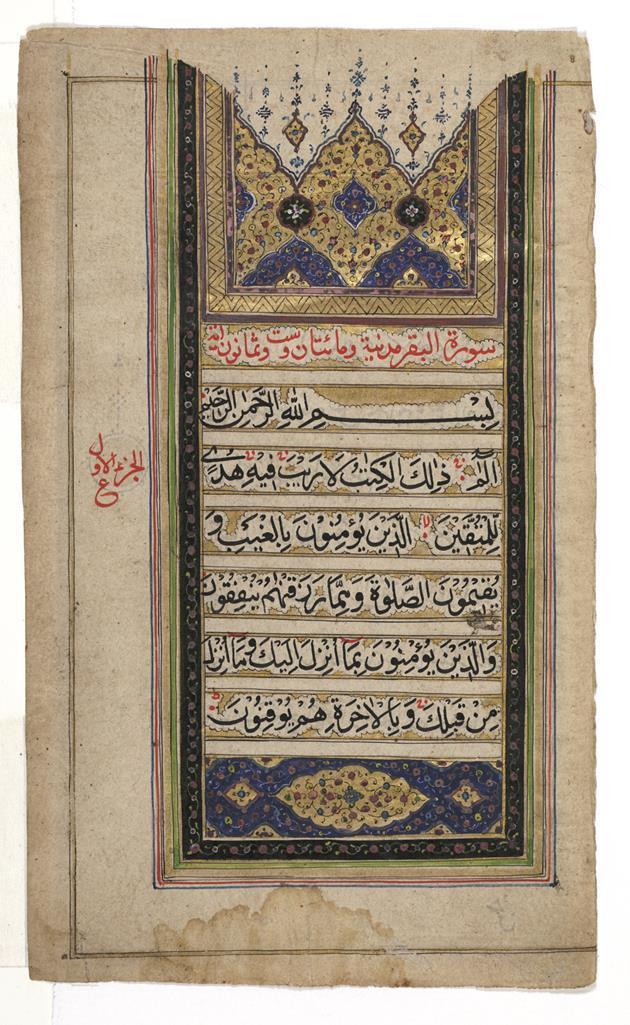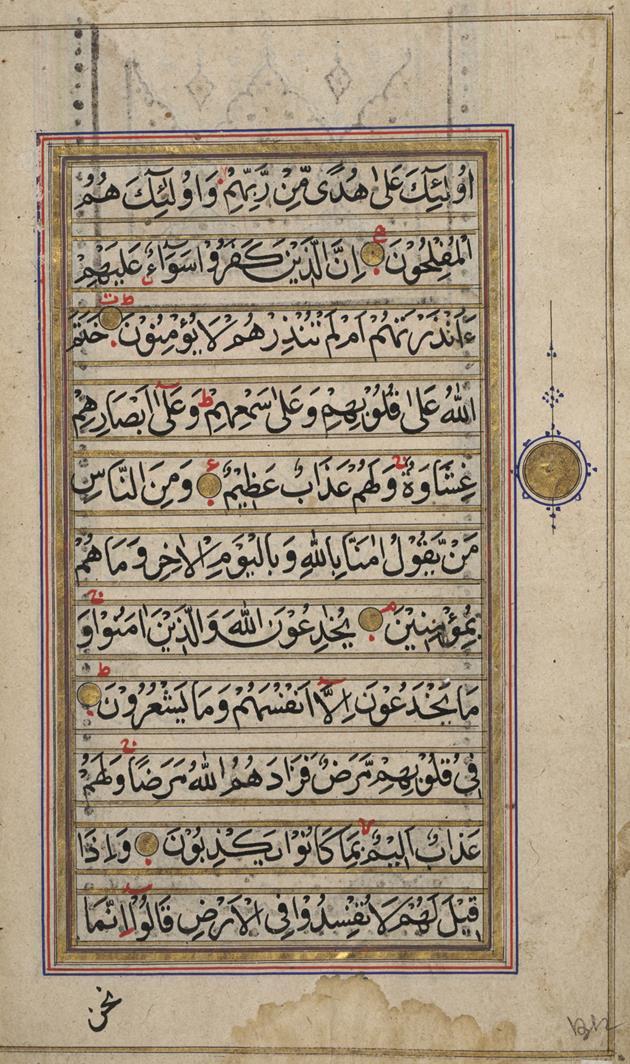Every mosque has a courtyard that serves as a gathering place and additional space for prayer. Courtyards can be ornamented by fountains and plants that allude to paradise, making the mosque a symbol of paradise on Earth.
The Great Mosque of Damascus, one of the largest mosques in the Islamic world, has a 36,000 square-foot courtyard (more than two football fields). The courtyard displays the wealth and power of the Umayyad dynasty, whose leaders had their capital in Damascus from 661 to 750, when they moved the center of power to Cordoba, Spain.
Courtyard, the Great Mosque of Damascus, Syria
Photo: Sarah Weatherby, licensed under Creative CommonsRelated Objects in SAM's Collection
Photo: Paul Macapia
Portable Qur'an, 1845, Persian, 49.174
Photo: Paul Macapia
Kufic page from the Qur'an, 11th century, Persian, 47.100
Courtesy Samarra Archaeological Survey
View of al-Mutawakkil's great mosque spiral minaret, Samarra, Iraq
Djenne Great Mosque, Djenne, Mali
Interior of mosque in Córdoba, Spain
In addition to an open courtyard, all mosques have a prayer hall-a covered area reserved for worship and study. Prayer halls are generally rectangular or square, and depending on local architectural styles, they can be subdivided by columns or crowned by soaring domes.
The Great Mosque of Córdoba, in Spain, has an extraordinary prayer hall that consists of a forest of columns supporting multicolored arches. The builders of this mosque used marble from ancient Roman buildings and medieval churches, giving it a dazzling variety of beautiful and colorful columns. The borrowed columns were generally not very tall, so the builders erected a double set of arches over them to raise the ceiling and create a more open and airy space.
Süleymaniye Mosque, Istanbul, Turkey
"Open and airy" would also describe Turkish mosques, like the Süleymaniye mosque in Istanbul, which are invariably crowned by massive domes. Smaller domes and half domes surround the main vaulted area, creating vast, lofty spaces for prayer.
The Qur'an does not contain any specifications about the form of a mosque, and the ritual of Muslim prayer requires only that the faithful face Mecca when they pray. This lack of specific requirements gave designers of mosques great latitude in shaping a Muslim communal prayer space. The courtyard-style mosque seen throughout the Muslim world today borrowed for its form a typical Middle Eastern/Mediterranean house, elaborating on the design by incorporating local architectural styles and traditions.
The form of a mosque and a church differ in a variety of ways. In a mosque, the clear indication of the direction toward Mecca is central, but the plan of the building is not organized around that directional focus. In a church, the arrangement of the space guides the worshipper's focus toward the east. In general, a mosque is a nonhierarchical, democratic space that has no privileged area for clergy or the wealthy. The entire prayer hall is uniform in design. In a church, the area closest to the main altar is reserved for clerics and society's elite; the closer you are to the east, the closer you are to God.
According to Muslim belief, the Qur'an—the holy book of Islam—consists of the revelations the Prophet Muhammad received from God through an intermediary, the angel Gabriel. The text of these revelations is divided into chapters (surahs), and verses (ayahs) and then arranged according to the length of the chapters, from longest to shortest. Originally, the content of the Qur'an was preserved orally. It was written down later to maintain the accuracy and purity of the word of God. In the copying and codifying of the Qur'an's teachings, we can also see the development of the grammar and script of the Arabic language.
Kufic page from the Qur'an, 11th century, Persian, 47.100
Photo: Paul Macapia
A minbar is a pulpit made of wood or marble from which religious leaders deliver sermons or political speeches to their fellow worshippers. The oldest minbar in the Islamic world is in the Great Mosque of Kairouan, Tunis, and dates to about the year 862. The patron imported teak from Java and commissioned artists from Iraq to construct the minbar. The combination of exotic materials and foreign artists made this pulpit both costly and highly prized.
Minbar, Great Mosque of Kairouan, Tunisia
Creswell Archive, Ashmolean Museum, neg. EA.CA.254The mosque (masjid in Arabic, which translates literally to "a place of prostration") serves a multitude of functions in Islamic society. It is first and foremost a place for communal prayer, particularly the Friday noon prayer. Through history, the mosque has also been a social, political and educational space, and it continues to serve these functions to the present day.
The architectural form of a mosque generally consists of a covered prayer hall connected to an open courtyard. The structure is usually square or rectangular, and the central courtyard is most often surrounded by porticoes or arcades. Within the prayer hall, a wall—called the qibla wall—indicates the direction toward Mecca, as it is toward Mecca that Muslims direct their prayers. A mihrab, or prayer niche, in the qibla wall provides a more specific indication of the direction toward Mecca. A pulpit known as a minbar usually flanks the mihrab and is used for sermons after the Friday noon prayer.
A mosque is generally a nonhierarchical, open space that lends itself to social gatherings, study, prayer and contemplation. It is often the focal point of the neighborhood or quarter in which it is located and the symbolic center of the local Muslim community.
Süleymaniye Complex, Istanbul, Turkey
Photo: Walter B. Denny
Mihrab, Great Mosque of Córdoba, Spain
Mihrab, Great Mosque of Córdoba, Spain
Mihrab ceiling, Great Mosque of Córdoba, Spain
Mihrab tile, 18th Century, Northern Iran, Kashan, 38.24
Photo: Beth Mann
Tabriz Prayer Rug, early 20th Century, Persian, 53.162
















